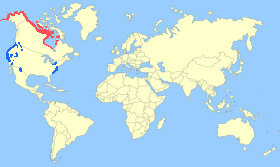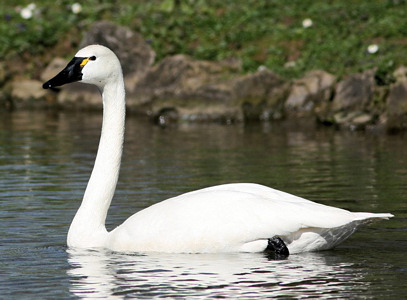Appearance: - The Whistling Swan is similar to the larger Trumpeter Swan and has a white plumage, a black beak with a salmon-pink streak along the mouthline and variable amounts of yellow at the base of the beak which may be lacking, dark-brown eyes, and the legs and feet are black. The female (Pen) is similar to the male (Cob) but is usually slightly smaller.
Size: - Typical Adult is 115-150cm (45-59in).
Food: - Mainly aquatic plants, leaves, roots stems, but will also graze on grasses, and grain. They will also eat animal matter such as aquatic insects, larvae, and freshwater molluscs.
Habitat/Range: - Lakes, marshes, estuaries in the Arctic tundra region of coastal Alaska, and northern Canada. Winters down the Pacific coast to mid-California, and down Atlantic coast from Maryland to South Carolina, also in the Great Lakes.

 Breeding Habitat/Resident,
Breeding Habitat/Resident,  Migration or Winter Area.
Migration or Winter Area.Breeding Season: - Mid-May in coastal tundra regions.
Eggs: - 5 to 6 (creamy white colour).
Notes: - The Whistling Swan and the Bewick's Swan are known as Tundra Swans. They are called Whistling Swans not because of their call but because of a high-pitched sound made by their wings whilst in filght.
Conservation status (IUCN 3.1):
Least Concern.
Classification: - Family: Anatidae,
Subfamily: Anserinae, Genus: Cygnus.















